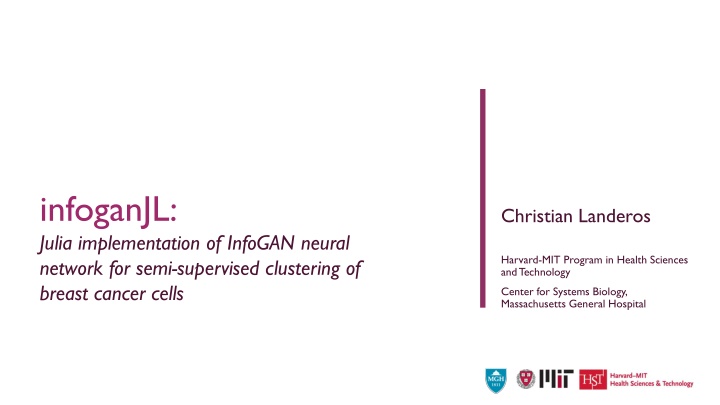Implementation of InfoGAN Neural Network for Breast Cancer Cell Clustering
Julia implementation of InfoGAN neural network for semi-supervised clustering of breast cancer cells. The project aims to address diagnostic bottlenecks in low-resource settings by utilizing digital holography for molecular data acquisition. By analyzing key hormone and growth factor receptors on breast cancer cells, the system informs clinical decision-making in a cost-effective and efficient manner.
Download Presentation

Please find below an Image/Link to download the presentation.
The content on the website is provided AS IS for your information and personal use only. It may not be sold, licensed, or shared on other websites without obtaining consent from the author.If you encounter any issues during the download, it is possible that the publisher has removed the file from their server.
You are allowed to download the files provided on this website for personal or commercial use, subject to the condition that they are used lawfully. All files are the property of their respective owners.
The content on the website is provided AS IS for your information and personal use only. It may not be sold, licensed, or shared on other websites without obtaining consent from the author.
E N D
Presentation Transcript
infoganJL: Julia implementation of InfoGAN neural network for semi-supervised clustering of breast cancer cells Christian Landeros Harvard-MIT Program in Health Sciences and Technology Center for Systems Biology, Massachusetts General Hospital
OVERVIEW Problem Motivation InfoGAN Background Implementation Design & Results
OVERVIEW Problem Motivation InfoGAN Background Implementation Design & Results
Problem Motivation Breast Cancer Biopsy Analysis Presence of key hormone and growth factor receptors on breast cancer cells inform clinical decision-making
Problem Motivation Breast Cancer Biopsy Analysis Presence of key hormone and growth factor receptors on breast cancer cells inform clinical decision-making For low-resource settings, time-consuming and costly biopsy analysis methods create diagnostic bottlenecks Tsu, V. D., Jeronimo, J., & Anderson, B. O. (2013). Why the time is right to tackle breast and cervical cancer in low-resource settings. Bulletin of the World Health Organization, 91, 683-690.
Problem Motivation Digital Holography for Low-Cost Molecular Data Aquisition Computational Reconstruction Digital Holography Bright-field Image
Problem Motivation Digital Holography for Low-Cost Molecular Data Aquisition Not very feasible for low- resource settings Computational Reconstruction Digital Holography Bright-field Image
Problem Motivation Breast Cancer Biopsy Analysis Single-cell Cut-outs size = (64,64,2)
OVERVIEW Problem Motivation InfoGAN Background Implementation Design & Results
InfoGAN Background Classification by Generative Adversarial Networks Single cell under imaged by digital holography Key assumption: Any data sample is the end result of a generative process where complex interactions from many independent factors generate data variability
InfoGAN Background Classification by Generative Adversarial Networks Example: background illumination number of cells red coloration ovalness of cell #1 Key assumption: Any data sample is the end result of a generative process where complex interactions from many independent factors generate data variability
InfoGAN Background Classification by Generative Adversarial Networks Example: background illumination Features that we care about and want to learn number of cells red coloration ovalness of cell #1 Key assumption: Any data sample is the end result of a generative process where complex interactions from many independent factors generate data variability
InfoGAN Background Classification by Generative Adversarial Networks
InfoGAN Background Classification by Generative Adversarial Networks
InfoGAN Background Classification by Generative Adversarial Networks
InfoGAN Background Classification by Generative Adversarial Networks We want to minimize entropy of this distribution to so that c provides maximum information
OVERVIEW Problem Motivation InfoGAN Background Implementation Design & Results
Implementation Design & Results Network Architectures
Implementation Design & Results Network Architectures

